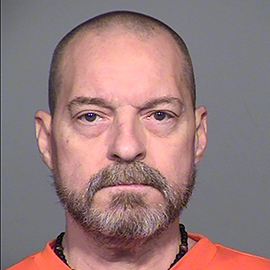- Slug: BC-CNS-Jones Execution,670 words.
- 2 file photos available (thumbnails, captions below).
By Ian McKinney
Cronkite News
WASHINGTON – State officials told the U.S. Supreme Court Wednesday that a lower court gave too much weight to mitigating factors when it ordered a new sentencing for Danny Lee Jones in a pair of brutal 1992 murders in Bullhead City.
But Jones’ attorney argued just the opposite. While conceding that Jones was guilty of “brutal crimes,” including the strangulation of a 7-year-old girl, the defense attorney said a lower court judge “serially nit-picked” evidence of Jones’ brain damage and abusive childhood to support the death sentence for him.
“You know, brutal crimes here. We acknowledge that, but there’s a lot of mitigation,” said Jean-Claude Andre, pointing to “long-standing childhood trauma, a lot of head injuries” and more that were not introduced until after Jones was convicted and sentenced.
But Deputy Solicitor General Jason Lewis said lower courts correctly balanced those factors against the brutality of Jones’ crime.
“In our view, the aggravating evidence is so compelling and the mitigating evidence that was developed in the federal evidentiary hearing is … is so slight,” Lewis told the court.
The case began in March 1992 when Jones and Robert Weaver were involved in a violent fight, after consuming large amounts of drugs and alcohol. During the fight, Jones beat Weaver to death with a baseball bat, then turned on Weaver’s grandmother and daughter, 7.
The girl was dead at the scene and the grandmother died months later of her injuries. Jones stole Weaver’s guns and the grandmother’s car and fled, according to state documents.
Jones was convicted in September 1993 on theft, attempted murder and two counts of first-degree murder and sentenced to death in December 1993.
But Jones later argued that his defense was flawed by an ineffective trial attorney, a public defender with just three years in practice and no experience handling capital cases.
Among other problems, the attorney failed to fully investigate Jones’ troubled past until after his conviction. It was only on appeal, after his sentencing, that the attorney presented fuller evidence of “mitigating factors” – elements balanced against aggravating factors to determine if a convicted criminal should get the death penalty.
The attorney subsequently presented evidence that Jones had received treatment for mood disorders, had attempted suicide, spent time in a mental institution, and suffered multiple neurochemical deficiencies.
“Not only do you have, again, actual diagnoses that are finally coming in 2006, that the sentencer didn’t hear in 1993, you also have additional facts that give rise to those various diagnoses,” Andre told the justices Wednesday. “So you have additional head injuries and you have a dramatically more significant history and pattern of abuse.”
That new evidence “would have dramatically changed the sentencing calculus both in the trial court and before the Arizona Supreme Court on its independent review,” Andre said. But a federal district judge disagreed, saying the aggravating factors still outweighed the new mitigating factors.
A three-judge panel of the 9th U.S. Circuit Court of Appeals reversed that ruling in 2021, later affirming its own ruling in 2022. That sparked the state’s appeal. Lewis said Wednesday that the circuit court “erred by failing to meaningfully consider the aggravating evidence or its weight.”
Justices appeared to struggle with the question of how much fact-finding an appeals court should do or whether that should be left entirely to trial courts. Chief Justice John Roberts at one point asked Lewis, “What do you want us to say that we haven’t said already?” to help guide lower courts.
Justice Sonia Sotomayor also asked Lewis why the state was asking the court to reverse the circuit court rather than simply vacating the lower court’s ruling and sending the case back for the appellate court to reconsider. Lewis said that the case has dragged on long enough.
“The circuit court has had this case for so long and has spent so much time granting relief on certain issues, reserving other ones, and then having it sent back continuously, it has to end at some point,” he said.
For more stories from Cronkite News, visit cronkitenews.azpbs.org.
^__=
Web links:
_ Argument transcript: https://www.supremecourt.gov/oral_arguments/argument_transcripts/2023/22-982_5iel.pdf
_ Argument audio: https://www.supremecourt.gov/oral_arguments/audio/2023/22-982
_ State petition: https://www.supremecourt.gov/DocketPDF/22/22-982/262951/20230406135715287_Thornell%20Petition.pdf
_ Jones response: https://www.supremecourt.gov/DocketPDF/22/22-982/276057/20230823234332124_22-982bio.pdf
_ Death row inmates: https://corrections.az.gov/death-row
^__=
The Supreme Court was asked to determine if lower courts erred by failing to give proper weight to mitigating circumstances when they sentenced Danny Lee Jones to death for two 1992 Bullhead City murders – or whether they gave too much. (File photo by Haley Smilow/Cronkite News)
Danny Lee Jones was convicted in the 1992 beating death of a friend, strangulation of the friend’s daughter and attempted murder of the friend’s grandmother. (Photo courtesy Arizona Department of Corrections, Rehabilitation and Reentry)

